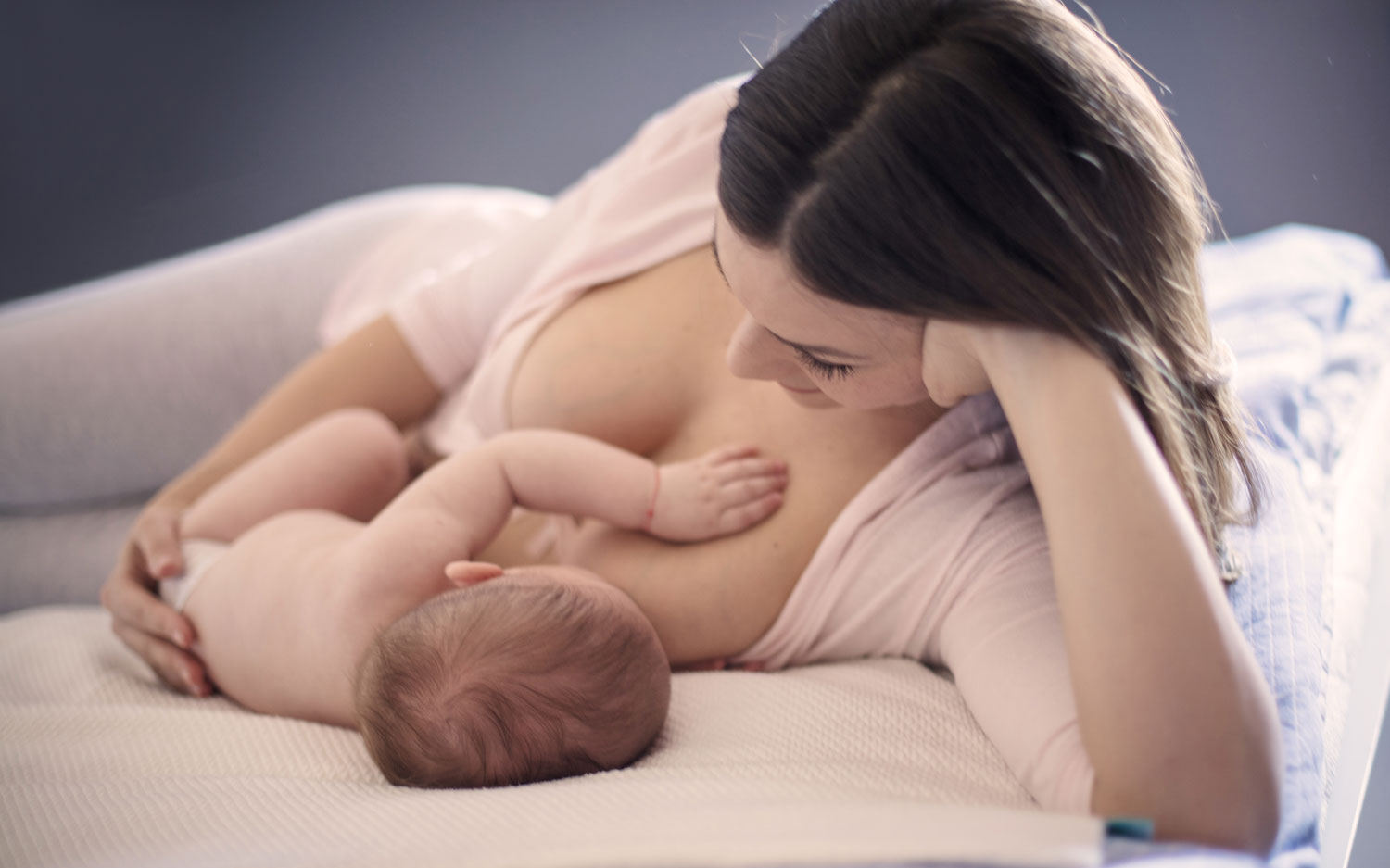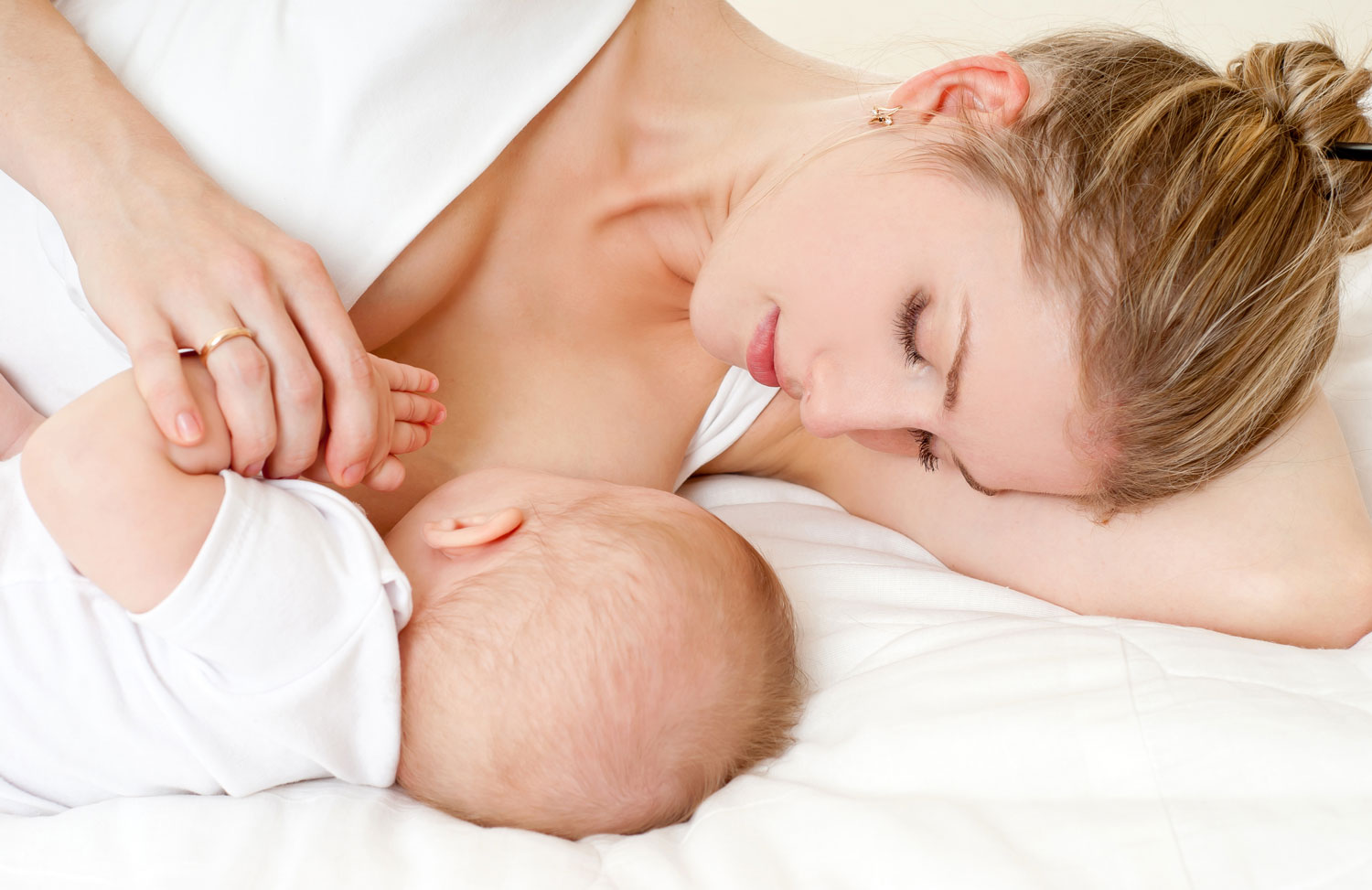Historically, women all over the world have effectively combined co-sleeping and breastfeeding for thousands of years. This is in order to meet the psychological, physical and social needs of their infant. Breastfeeding infants feed regularly throughout the day and night time during the early months of life. Mothers who are breastfeeding their infants need to be in close proximity to their infants. This allows them to read their infant’s cues and meet their needs for nutrition, comfort and safety.

According to McKenna and McDade “mother-infant co-sleeping represents the most biologically appropriate sleeping arrangement for humans and is both ancient and ubiquitous simply because breastfeeding is not possible, nor as easily managed without it.”(1). “Human infants are born more helpless than any other animal species”. (2) and with only 25% of their adult brain size in comparison to other mammals who are born with their brain at 60-90% of its adult size. Human infants, therefore, belong in a biologically dependent state for a longer period of time. (2) A study exploring the relationship between breastfeeding behaviour and routine sleep arrangements of mother-infant breastfeeding dyads over three consecutive nights concludes that routine bed-sharing was “…associated with a significantly greater number of feeds per night compared to mother-infant dyads who routinely sleep separately from one another in different rooms”(3).
Effects of Co-Sleeping on Breastfeeding
The effects of co-sleeping for the breastfeeding infant and their mother include and we do not limit to: greater milk supply due to the baby feeding more regularly throughout the night which assists with milk production; more frequent breastfeeding which means that the infant cries less, is able to conserve their energy and spends more time in calm wakefulness; longer breastfeeding sessions and breastfeeding duration. The infant who co-sleeps experiences increased safety. They feel safe as mothers can constantly monitor them throughout the night. Infants have lower stress levels as they do not have to cry long enough to awaken their parents who may be sleeping rooms away from where they are and ”they achieve longer and better rest periods.”(2)
Babies who co-sleep have an increased sensitivity to their mother’s communication (smells, movements and touches- and visa versa). They have better temperature regulation because their mother can sense and respond to their needs for warmth and cool. Mothers may also experience enhanced attachment and parental fulfilment especially if they are working and are away from their infant during the day. (2) Finally and of great significance, “Not breastfeeding is now known to be an independent risk factor for Sudden Infant Death Syndrome(SIDS) as is an infant sleeping alone in a room by itself” (3 & 4). Also, “bed-sharing promotes infant arousal which may be protective against SIDS”(5)
What is Co-Sleeping
Co-sleeping is defined as “…a practice in which babies and young children sleep close to one or both parents, as opposed to in a separate room.” (6) Bed sharing is a practice by which the infant shares the same sleep surface as one or both parents/caregiver. McKenna and colleagues provide a more descriptive definition of mother-infant co-sleeping to be “…any situation in which a committed mother sleeps within sensory range of an infant (on the same or different surface) permitting mutual monitoring, sensory access and physiological regulation, including (but not limited to) the delivery and ingestion of breast milk.”(3)
We can say then that co-sleeping refers to room sharing and/ or bed-sharing and many mother-infant dyads may alternate their sleep environment between room and bed sharing on more than one occasion throughout any one night. Infant sleeping practices vary enormously across many cultures and nations and in many of them co-sleeping is the norm until they wean children or sometimes long after weaning.
Examples of global co-sleeping practices are that in Japan parents often sleep in close proximity with their children until they are teenagers.
This sleeping arrangement is described by Japanese people as; the mother is a river bank and the father is another and their child sleeping between them is the river. (2) Similarly a study in 2006 of Indian children aged 3 to 10 reported that 93% of them were ‘bed sharing’ with their parents.
In Latin America, the Philippines and Vietnam, some parents sleep in a hammock with their baby next to the bed, while others may place their baby in a wicker basket between the parents in the adult bed. (2) Many cultures that routinely practice co-sleeping have very “rare instances of Sudden Infant Death Syndrome (SIDS). (1, 2) Maternal smoking rates in these cultures are also low and “SIDS is either considered rare or is unheard of”. (2) It is well known that a combination of bed-sharing and smoking by one or both parents increases the infant’s risk of SIDS. (5)
How Many Parents Co-Sleep
Co-sleeping is not an unusual practice for families living in the USA and Australia. In the USA, 44% of infants between 2-9 months of age are co-sleeping. They are co-sleeping in an adult bed at any given time (2). Consistent with rates in the USA, a recent Australian unpublished study of 1000 mothers of children aged up to two years of age showed that 41% of the mothers surveyed “allowed their baby to sleep in their bed with them”(7). Studies considered parents/caregivers sharing an adult bed with their infant a risk factor for sudden infant death syndrome. In certain situations is not recommended by health and government authorities. (8) Most recent figures on sudden and unexplained death of an infant (SUDI) (including SIDS deaths) equated to 0.5 per 1000 births in Australia in 2010(34 of these deaths occurring in NSW).(10)
Where all known risk factors are absent, are hospital policies and procedures increasingly leaving bed-sharing families educationally stranded without safety information? What information do we discuss with parents in regards to ‘safe sleeping practices’?(1)
An objective of the NSW Ministry of Health policy on ‘Safe sleeping in NSW Health maternity facilities’ is that parents are “strongly encouraged to maintain the practices outlined within the document when they return home”.
In line with ‘SIDS & Kids’ recommendations, the policy directive encourages the following: babies to be placed to sleep in the supine position from birth (on their backs), a safe cot, safe bedding, a safe mattress and to ensure that the babies face remains uncovered during sleep. The policy directive then discusses that parents should be provided with the following information to help them to provide a safe sleeping environment should they choose to take their babies into bed with them: sharing the same sleep surface with a baby is not recommended where one or both of the parents are smokers; baby can get caught under adult bedding or pillows, where the baby can get caught between the wall and the bed or fall out of bed; where the baby can be rolled on by somebody who sleeps very deeply or is affected by drugs or alcohol; where babies are in adult beds alone; and when the baby is placed to sleep on a sofa, beanbag or sagging mattress(e.g. water bed). The policy directive then has a link through to the ‘SIDS and Kids’ website where the above safe sleeping guidelines are repeated as well as some added information encouraging the baby to be placed in the cot in the same room as the parents for the first six to twelve months of life.(8)

Where will the mother go to feed her baby throughout the night? Prior to leaving the hospital, mothers may not have considered where about within their home environment they will feed their baby throughout the night. Due to the possibility that the mother may be feeling it is unsafe to feed her baby. She may feel unsafe feeding whilst lying in bed. Mother may choose to breastfeed her infant while sitting on the couch. Mothers can also sit on a sofa or armchair. The mother may fall asleep whilst breastfeeding in an upright position on the couch which may increase the risk of a sleeping accident. This is supported by Vennemann and colleagues who say that “…sharing a sofa with an infant, which is becoming increasingly frequent in some countries is associated with a high risk of SIDS.”(5)
Caring for your Baby at Night
‘Caring for your baby at night’ a parent information leaflet (written by BFI UK, UNICEF UK, Royal College of Midwives, UNITE the union, CPHVA and FSID the cot death charity) provides useful information on safe sleeping guidelines for parents along with safe methods of combining breastfeeding and co-sleeping and provides information on ways that parents can meet their needs for rest. The brochure addresses the following topics: getting some rest (parents). How partners can assist the mother throughout the night at feed time. What to do when baby doesn’t settle. Including a warning not to share your bed with your baby if you are a smoker. A warning not to sleep with them if you have consumed alcohol or taken drugs(legal or illegal). These will make you drowsy and not put yourself in a position where you could dose off with your baby. You may dose off on a sofa or in an armchair; safe and unsafe sleep surfaces and environments and precautions to take if you decide to share a bed with your baby. An alert on this page state that the safest place for the baby to sleep is in a cot by the side of the parental bed and then repeats in which situations it is not safe to bed share with the baby (as discussed above) as well as stating that it is not safe to bed-share in the early months if the baby was born small or preterm.
As we highlighted above, safe sleeping information and discussions are of major importance to parents/caregivers. It is in order for them to consider safe sleeping arrangements for their infant within their own home environment. Also to make informed decisions about where and how they will breastfeed, settle and sleep their infant. Parents require more information than a statement such as ‘It’s not safe to sleep with your baby’. As we discussed previously, 41% of mothers in Australia do bed share with their infant at night. This statement does not provide parents with information. Thi is in order for them to make informed and safe decisions. Decisions on where to sleep their infant and where to feed their baby throughout the night.
Reference List
- McKenna, J. and McDade,T.(2005). Why babies should never sleep alone. A review of the co-sleeping controversy in relation t SIDS, bed sharing and breastfeeding. Paediatric respiratory reviews. 6: 134-152
- McKenna J.(2007) Sleeping with your baby- A parent’s guide to co-sleeping. Platypus media, Washington
- Gettler, L & McKenna, J (2011).Evolutionary perspectives on mother-infant sleep proximity and breastfeeding in a laboratory setting. American journal of physical anthropology, 144; 454-462
- Blair. , Fleming, P., Smith, I., Platt, M., Young, J., Nadin, P., Berry,P., Golding, J.,& CESDI SUDI Research group(1999). Babies sleeping with parents; case control study of factors influencing the risk of Sudden infant death syndrome. British medical journal. 319, 7223; 1457
- Vennemann, M., Hense, H., Bajanowski, T., Blair, P., Comploger, C., Moon,R., Kiechl-Kohlendorfer ,U. (2012). Bedsharing and the risk of Sudden Infant Death Syndrome: Can we resolve the debate? Journal of Paediatrics 160:44-48.
- Wikipedia accessed 25/5/12 at : en.wikipedia.org/wiki/Co-sleeping
- SIDS AND KIDS. Shared sleeping surfaces linked to high percentage of sudden and unexpected infant deaths. Accessed at: www.sidsandkidsvic.org/images/stories/pdf/Statistics%20Release%208%20June%202010%20RND.pdf
- NSW Ministry of Health Policy Directive (PD 2005_594). Babies-Safe sleeping in NSW Health Maternity Facilities. Accessed at :www.health.nsw.gov.au/policies/pd/2005/pdf/PD2005_594.pdf
- Gettler, L., McKenna, J. (2009) The science of sharing sleep. Mothering. 152, 42-48
- SIDS and KIDS factsheets accessed 28/05/2012 at: www.sidsandkids.org/wp-content/uploads/2012-Fast-Facts.pdf
- ‘Caring for your baby at night”- parents brochure (accessed1/06/2012 at: www.unicef.org.uk/Documents/Baby_Friendly/Leaflets/caringatnight_web.pdf
- Blair, P. The Health professionals guide to ‘Caring for your baby at night’ accessed1/06/2012 at: www.unicef.org.uk/caringatnight
Article originally published in Midwifery Matters Vol. 3 No. 4 December 2012
Reviewed 2nd September 2020

Recent Comments